
The Illusion
The Illusion
The Illusion
The Illusion
The Illusion

by Bruce Cornet, Ph.D.
sound profile downloading; controls below:
On 12 November 1993 three people, including this writer, were standing beside West Searsville Rd. where Cornet had photographed unusual phenomena in the night sky numerous times before. At approximately 9:05 pm we spotted what appeared at first to be a small jetliner on approach to Steward airport (located ten miles away at Newburgh, NY). But after it passed low over us, making the obligatory sound of a jet aircraft, it suddenly made two steep banks or turns, and then seemed to dive at a high angle straight down towards the ground. My heart was in my throat as I fully expected to see a fireball rise up from behind the trees. But there was no explosion. There was nothing but deafening silence.

Images 1 - 4 show the FT as it approached from the west (lower left), climbing in altitude and then leveling off above us (image 5). The times for each time exposure are given in sequence to the lower right. Pay close attention to how the lights change in intensity, character, number, and color.
Note how an upwards "tail" occurs at the beginning of images 1-3. In the enlargements of the negatives below, the tails might at first be misinterpreted as camera jerks, or the movement of the camera as the shutter is opened. But that explanation does not account for the funnel shape of the main traces as the width of each trace narrows down. In addition, a tail or loop was produced in the middle of image 2, well after the shutter opened. Not only is there a loop, but a funnel afterwards, implying that this movement or feature was produced by the FT, and not by Cornet's camera.
So what you say! Doesn't prove that ET did it. Correct! But that's not the objective of this exercise. We are only analyzing data here in order to correctly understand the sequence of events and what really did happen. Any further interpretation is subject to opinion and bias. But for now the facts will do just fine. Question is: Are you capable of looking beyond your assumptions and biases, and able to see those facts? More importantly, are you willing to accept their implications?
Below are enlargements of the negatives. The bright white lights appear black in the images, while the night sky appears light.
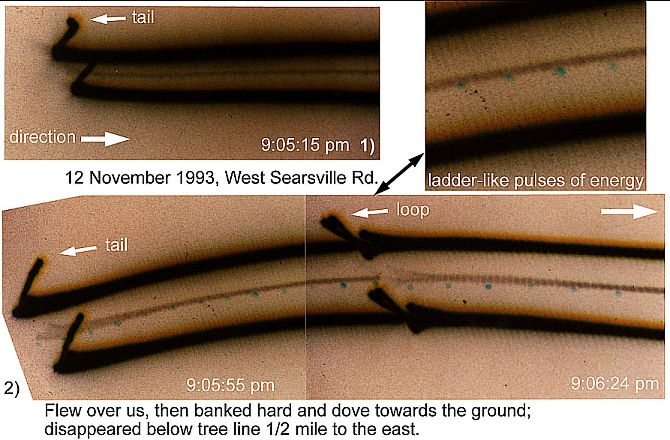
Note how the outer lights enlarge in brightness as the FT approached Cornet's camera, and then gradually dimmed (images 2-3). As the lights brightened, an aura of ionized air and orange-brown NO2 gas develops around them (Hill, 1995: p. 60-65). For a further discussion on why this gas is colored orange-brown, see Evidence for Plasma Light Source. This has been a consistent feature observed in photographs of AOP that have brightened their lights on approach. The graphs below show several examples of changing light intensity for AOP compared to that of a commercial jetliner. Due to atmospheric lensing, a distant light can appear brighter than normal. That is why the graph for the jetliner is sloped downwards towards the observer. When the jetliner turned towards the camera at the beginning of the graph, its lights appeared to brighten, then dim. The amount of brightening, however, does not compare with that intentionally done by the AOP, which show an increase of intensity from three to five times that of the jetliner.
Typical AOP performances and light shows:
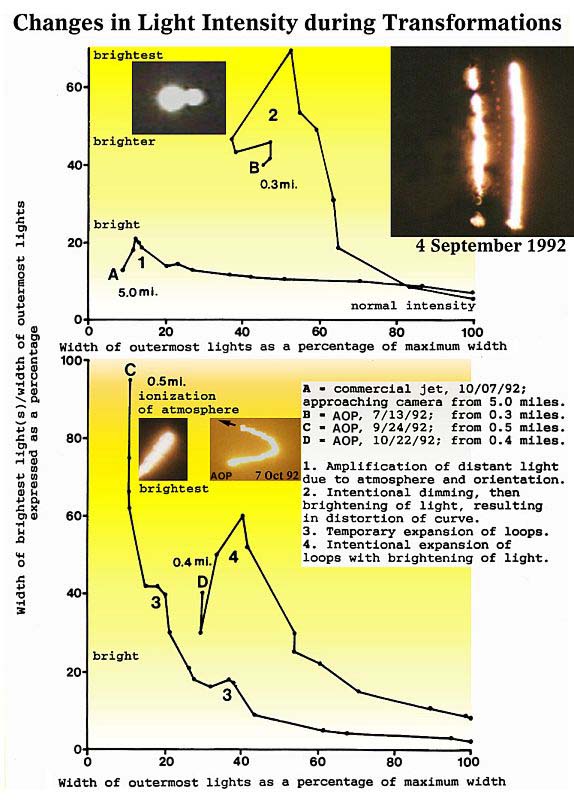
If you haven't noticed folks, the red-orange aura and extreme brightening (graph above) isn't normal behavior for lamps. Note the ladder-like pulses of plasma energy eminating from the lights. There is no conventional explanation for this pattern. The lamps of commercial or military aircraft cannot dance or make loops like this. These parallel pulses are interpreted as an interference pattern between the electromagnetic plasma lights and the propulsion system.
The loops and tails have been documented many times before by Cornet. In The Performance he gives detailed evidence which implies that the AOP itself did not make the loop. Only its lights moved. See Choreographed Tails. The "tails" at the beginning of time exposures could be jets of bright plasma gas being ejected orthogonal to the object's trajectory, whereas the "loops" could be created by a manipulated electromagnetic field around the object. Because plasma gases are created by highly charged atoms and electrons, they will respond to a strong magnetic field. That is how plasma gases are controlled and contained.
In the time exposure below (enlargement of negative), which was taken on 29 August 1992 at West Searsville Rd., an AOP makes its light loop, while its overall path remained straight and unchanged. Note how the intensity of the light changes non-uniformly within the loops. For the skeptics: The camera was solidly mounted on a stable tripod. The camera was not hand held. Camera movement would not produce this type of internal variation in a light, and aircraft cannot make tight loops like this.

After the 12 November FT flew over us, it began a slow descent as it crossed the field to our east. The pair of bright lights can be seen to dim further and develop into strobes, while the central light becomes braided into three lights. On commercial aircraft the brightest lights are the landing lights. They cannot be made to dim gradually (unless engineered to do so). They are either on low beam or high beam. And landing lights are not associated with strobes, which are typically placed at the wingtips. It makes no sense whatsoever to put landing lights far out at the tips of the wings, when light is needed directly ahead of the pilot as an aircraft lands.
As the FT crossed the field, two additional lights turned on to the east. They both moved to the south (or to the right). When Cornet opened the shutter to take image no. 7, both lights produced what he calls "tendrils," or a downwards spiraling pattern. Then as the FT approached the leading light, it turned off directly in front of the approaching FT, and then turned on after it had passed the FT. Commercial pilots would never do this, because they would want to be seen by an approaching aircraft. Turning off hazard lights is also against FAA regulations. So why does image no. 8 show this happening?
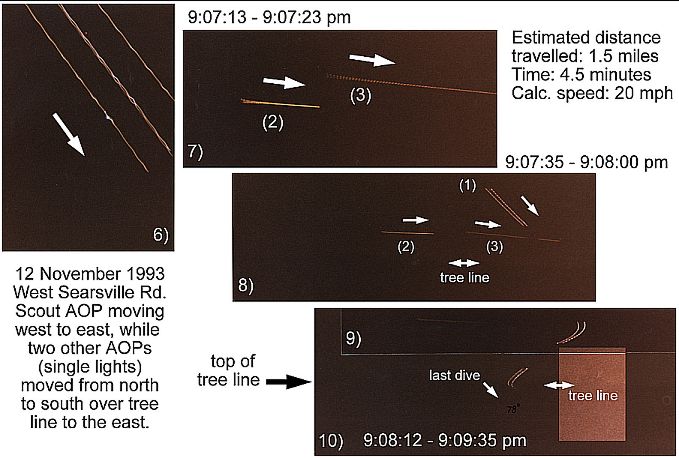
Cornet zoomed out to capture all the lights in the same frame, then zoomed in again for images 9-10. If one enlarges the light traces in image no. 8, you can see this phenomenon better, as well as the low altitude of the lights relative to the underlying tree line. One can also see an increase in the number of strobes along the right light of the FT, but not an equal number along the left light. Such an increase is also highly unusual, because strobes on commercial aircraft are hard wired and cannot be varied in their timing. The unbalanced pattern of strobes for both sides of the FT is also highly unusual or abnormal.
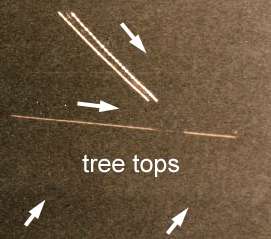
After the FT passed the other two lights, it turned sharply to the north or left and downward. It descended very slowly. The number of strobes again varied and is not regular. Shortly after the first turn the FT made a hard bank to the northeast as it continued to slowly descend towards the ground at an angle of about 45 degrees! It disappeared behind a front of trees. By noting the position of tree tops, it becomes obvious that this object went below 60 feet in what appears to be a crash landing, which no human pilot could pull out of in total darkness in the middle of a forest punctuated by patches of small farm fields. Even at a well-lit landing strip such a stunt at night would be highly dangerous, not to say against FAA regulations.
FAA regulation 91.303 Aerobatic flight. No person may operate an aircraft in aerobatic flight -- (a) Over any congested area of a city, town, or settlement; (b) Over an open air assembly of persons. For the purposes of this section, aerobatic flight means an intentional maneuver involving an abrupt change in an aircraft's altitude, an abnormal altitude, or abnormal acceleration, not necessary for normal flight.
But since this stunt took place at least four miles from the nearest airport (Orange County airport), it is illogical to try and explain it away as barnstorming by a daredevil pilot who would risk his life just to give a couple civilian bystanders a cheap thrill.
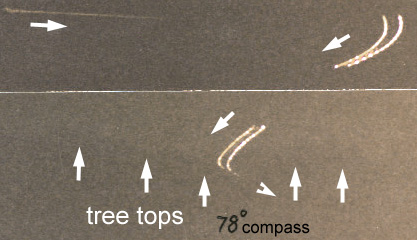
Now look at a composite reconstruction of the flight path, along with the tree line superimposed from another time exposure.
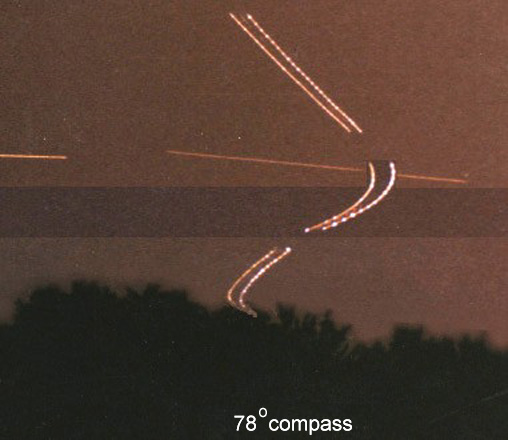
Is this the flight path of a conventional jetliner, or a pilot looking for a place to land? Or was someone showing off their advanced technology and flight capability? Below is a map showing an approximation of the flight path for this FT. Note how it seems to have gone down in a farm field. This is the same farm field from which other FTs and AOP have been photographed taking off. This is the same farm field which contains an unusual hexagonal Indian Mound defined by a 300 ft. circular base. This is the same farm field where very strange magnetic readings have been taken. No evidence has ever been found of wheel marks or landing marks in those fields. The farmer says that he has never seen or heard any aircraft land in his fields.
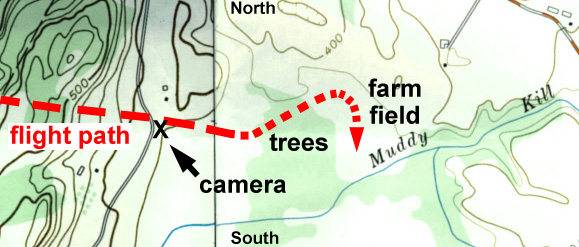
Below: Picture of farm field with possible flight path just after the FT disappeared behind the tree line to the left.
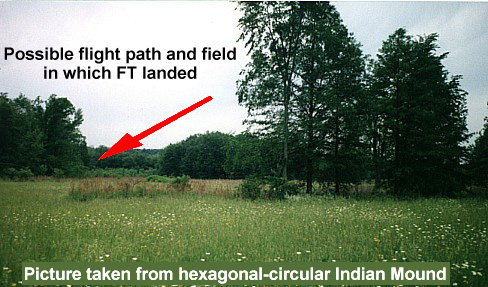
So......what was it?
Look at the sound profile (sound spectrogram) and compare it with that of a DC-9. There is little similarity.
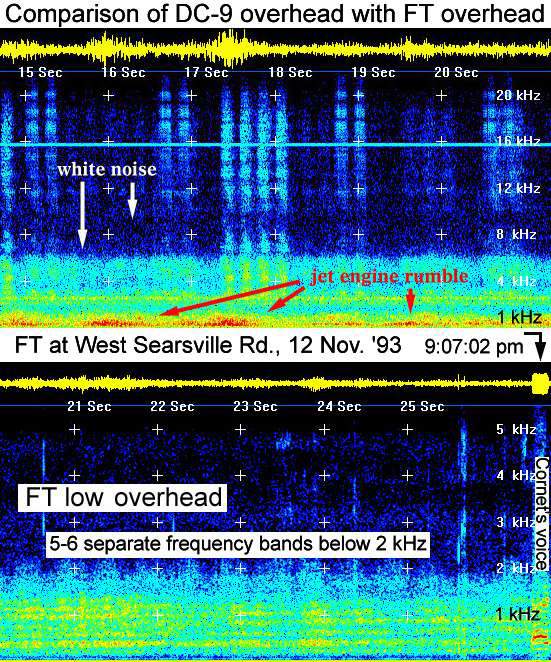
But if one compares the sound profile with that of another FT, which was videotaped during a performance on 28 April 1993, there is a significant amount of similarity (see The Performance on the BUFOD website).
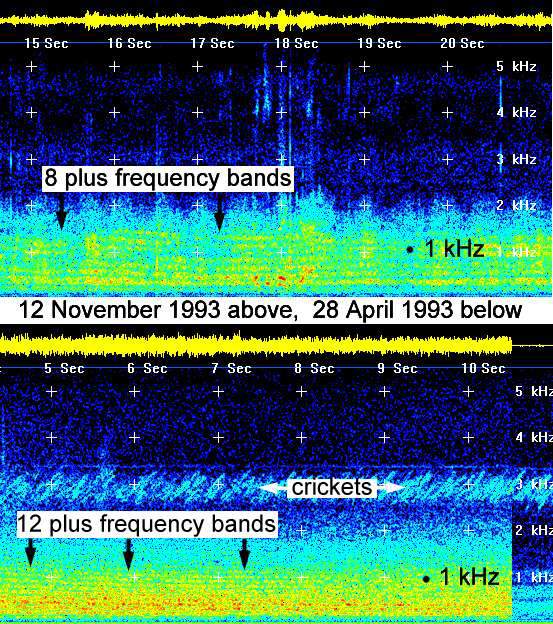
Listen to what was said on that evening as the FT flew overhead. At first Cornet thought he saw a diamond shape. But as the FT sound became louder, he was initially fooled by the sound (as you probably will be) into thinking that it was a commercial jetliner. However, upon further analysis the sound appears to be synthetic, or manufactured (like that of a midi, which is comprised of many individual electronic tones), and unlike the sounds of conventional jets.
Occam's razor is part of the scientific method, and serves a valuable purpose of weeding out unlikely possibilities when considering the facts. However, without considering all the facts, such as a frequency spectrogram, Occam's razor will select only the simplest or most parsimonious interpretation, but that does not mean it is the correct interpretation. Anyone familiar with human psychology could easily fool us with fake sounds, just as a magician fools us with slight of hand. Much more information is given on the comparison of sounds at The Performance website.
Download ftdive3e.wav (281K) by clicking on ft overhead.
Conclusion
Whatever flew over Cornet and two other witnesses that evening was not a conventional or normal aircraft. How can I say this? Based on the data collected, there are too many discrepancies with known physical phenomena associated with conventional aircraft to conclude the mundane. More importantly, it cannot be determined whose aircraft it was, or who was flying it. No amount of implication justifies an ET interpretation, period!
Nevertheless, the photographs speak loudly by raising questions about the light source (plasma?), the propulsion system (antigravitic?), and the nature of the flyover (dangerous stunt at night). These are legitimate questions. The unusual performance also raises significant questions about what this FT and its two companions were doing there that night, and where they came from.
Could this craft have been the Horten Pul 10, recently developed and engineered by Dr. Reiner Horten (the WWII German aircraft designer) and first flown in Argentina on 22 January 1990! Perhaps, but the power plant is the wrong type, unless the sound was intentionally masked to resemble a jet engine, and the landing distance is too great (700 feet) for what we saw go down. And then how do you explain the unusual behavior of the lights and the Nitrous Oxide aura as they brightened? You be the judge.
For all those who think that Cornet is mistaken (I did not say it was ET) and has misidentified conventional jetliners, you need to do your homework.
There is a mystery here. It is called the Pine Bush Phenomenon.
Reference
Hill, Paul R., 1995. Unconventional flying objects, a scientific analysis, Hampton Road Publishing Company, Charlottesville, VA.
Copyright B.Cornet 1999
Date this web page was last modified: 12/02/07